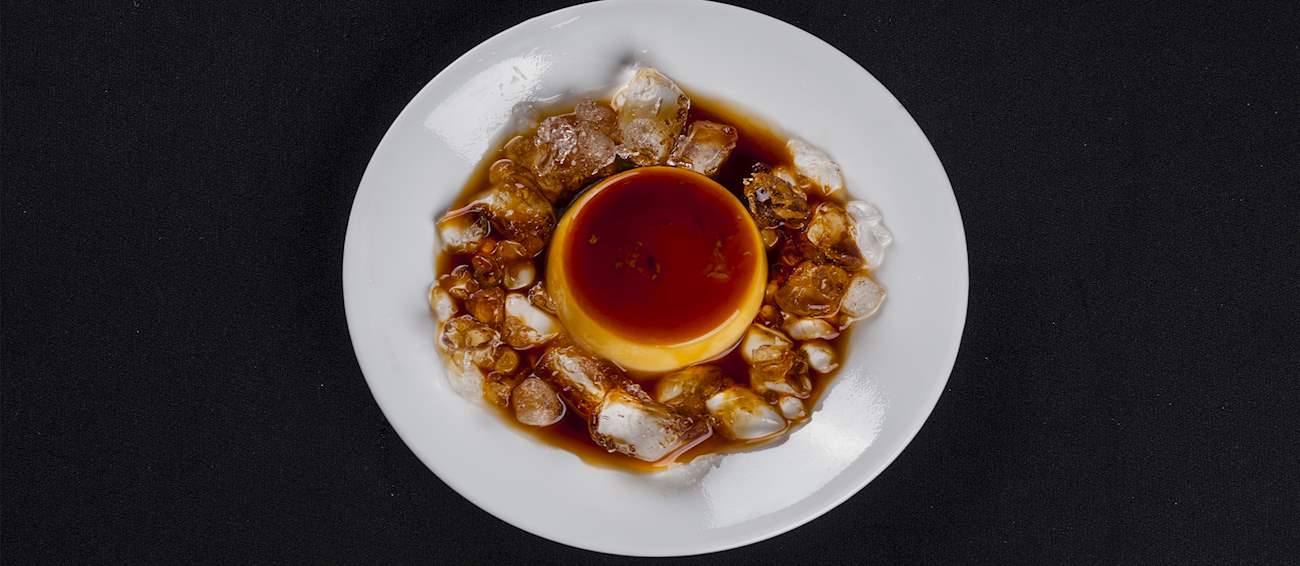Chè trôi nước is a Vietnamese dessert that combines sweet ginger-flavored soup and rice balls. The soup is usually sweetened with palm sugar, and it's sometimes additionally flavored with pandan leaves, while the filling inside the glutinous rice balls traditionally includes a combination of coconut milk and mung bean paste.
Although it is considered a traditional Vietnamese specialty, it is believed that the dish was modeled on tangyuan—a similar sweet soup of Chinese origin. Chè trôi nước is always served warm, typically garnished with coconut milk and roasted sesame seeds.
MAIN INGREDIENTS
Chè ba màu is a colorful Vietnamese dish that belongs to the category of desserts, drinks, puddings, porridges, and soups regarding its consistency. It might include sticky rice, tapioca pearls, lotus seeds, sweet beans, water chestnuts, or agar jelly.
Regardless of the wide variety of ingredients used in chè, they are almost always drenched in coconut milk and additionally garnished with bananas, crushed peanuts, or other toppings. The dish is served either hot or cold, although it is especially popular as a chilly treat on hot summer days.
Bánh flan is the Vietnamese version of crème caramel. Tender and soft, covered with a layer of sugary caramel, the French crème caramel is a timeless and classic dessert. The Vietnamese variety was directly influenced by the French, who left a significant impact on the culture and gastronomy in Vietnam during the colonization period.
Although simple in ingredients and preparation, bánh flan is a beautiful and delicate dessert. It usually employs a rich vanilla or coffee-flavored mixture of milk and eggs, which is poured in caramel-covered ramekins. When cooked, the flan is turned upside down, leaving a layer of dark, thick caramel sauce on top, which generously descends on the sides, covering the entire cake in an appetizing amber color.
Fried bananas are a popular Vietnamese street snack usually made with small, fragrant, and ripe chuối xiêm bananas. Before they are fried, lengthwise banana slices are flattened and then coated in a batter that typically combines rice and wheat flour, coconut milk or coconut cream, sugar, and various optional additions such as cinnamon, shredded coconut, flavorings, or honey.
Fried bananas are best served warm, and they are occasionally sprinkled with sesame seeds and accompanied by coconut sauce.
This traditional Vietnamese dessert consists of chewy layers that are typically made with puréed mung beans, tapioca starch, rice flour, and coconut milk or water. Traditionally, each cake has a pale yellow layer made with mung beans and a green layer that is flavored and colored with pandan leaves, while optional ingredients include durian or taro.
Once steamed and chilled, the cake is usually cut into diamond shapes.
Pop rice is a traditional puffed rice treat originating from the Mekong Delta area. This crispy puffed rice is made with a decades-old technique. Whole grains of rice with their husks intact are poured into a large pot that’s previously been filled with black sand from the Mekong River.
As the mixture is stirred over a fire, the rice begins to puff and pop, and it is later filtered twice through a mesh in order to remove the black sand and the remaining husks. The crispy rice is then placed into another wok-shaped pot and mixed with a syrup consisting of sugar and water.
Rau câu is a Vietnamese jelly cake made with agar (gelatinous seaweed), coconut milk, condensed milk, and flavorings such as coconut, banana, chocolate, mocha, and vanilla. The texture is similar to that of panna cotta. Due to the usage of agar jelly, rau câu provides a great alternative for vegetarians who prefer not to consume animal gelatin.
The dessert can be found in numerous Vietnamese delis and banh mi shops, while similar treats are also prepared throughout Southeast Asia and Indonesia.
Vietnamese chè dishes include any traditional sweet soup, beverage, pudding, or any other custard-like dessert that is made with a base of either water or coconut cream and served either hot or cold. Other ingredients for making chè include various jellies and fruits, beans and pulses, rice and grains, and even tubers and cereals.
It is believed that chè desserts originated in the central region of Vietnam, but today they are widely available throughout the country and prepared in countless variations. Because of their hearty contents like beans and sticky rice, they are a popular snack item commonly sold in plastic cups at Vietnamese grocery stores, while one of the most popular chè varieties prepared at home is the so-called chè đậu trắng.
VARIATIONS OF Chè
MOST ICONIC Chè
View moreMAIN INGREDIENTS
This versatile dessert usually consists of a cream base that is enriched with various ingredients. Typical additions include various types of canned fruit such as lychee, jackfruit, longan, or red-colored water chestnuts, as well as coconut milk, pandan-flavored jelly, and the sweet liquid in which the fruit was preserved.
The dessert is finished off with the addition of ice cubes and should be served immediately.
Bánh bò are traditional, coconut-flavored Vietnamese sponge cakes that are prepared with a light yeast-based batter. There are several varieties depending on the shape, ingredients, and the method of preparation, but all of them have a distinct, airy texture which is why they are occasionally known as honeycomb or beehive cakes.
Bánh bò cakes can be baked or steamed and tinted with various natural colorings, while their base is usually made with rice or tapioca flour. The name bò roughly translates to a cow or to crawl, but it is not clear how and why the cakes were given their current name.
TasteAtlas food rankings are based on the ratings of the TasteAtlas audience, with a series of mechanisms that recognize real users and that ignore bot, nationalist or local patriotic ratings, and give additional value to the ratings of users that the system recognizes as knowledgeable. For the “Top 28 Vietnamese Desserts” list until March 15, 2025, 1,130 ratings were recorded, of which 406 were recognized by the system as legitimate. TasteAtlas Rankings should not be seen as the final global conclusion about food. Their purpose is to promote excellent local foods, instill pride in traditional dishes, and arouse curiosity about dishes you haven’t tried.



















